HOSTS- Jeremy Burns, Matthew Scott Phillips
TYPE- Ear Training
DURATION- 71:17
BUMPER MUSIC- "Pretty Catchy Melody" (Area 47 Music)
ANNOUNCER- Mike Cunliffe
A melodic dictation exam is something you may or may not have to reckon with in your musical journey. Passing this course is essential for a music student working towards a degree. But for anyone, academia aside, these tips and tricks will help you know melody better. We will discuss how to establish your tonal "home base" and how to recognize what parts of the scale are being used in the melodic line. We will also spend a little time talking about solfége (fixed "DO" and movable "DO") and how it compares to the number system that we tend to use in theory and analysis. Get ready to sharpen
your sense of melody!
MELODY- A succession or arrangement of notes forming a distinctive sequence or theme, often repeated or revisited through out the piece. This is the horizontal aspect of music.
SCALE- A pattern of notes, arranged in whole steps and half steps, that span an octave.
TONIC- The root or foundation of a key or scale. This is scale degree 1. The ultimate directional goal of harmony.
MELODIC DICTATION TIPS
BEFORE YOU HEAR THE FIRST NOTE OF THE MELODY YOUR TRYING TO ANALYZE...
1. IDENTIFY THE TONIC
Listen to all the textures and see if you can identify "home base". This will help later when you engage your theory brain to figure out what this melody is made of. In an aural skills class, your instructor will establish this before they play the melody in question.
2. HOLD ONTO "DO", (SCALE STEP ONE)
If you know where home base is, you should be able to find "DO", or scale step 1. Try to hold on to that tone in your inner ear as you listen to the melody in question.
3. ESTABLISH THE RHYTHM
Sync your internal clock with the tempo and time signature of the melody in question. Count in your head as you listen to the melody in question.
THE FOLLOWING EXAMPLE WILL CORRESPOND WITH THE FIRST EXAMPLE IN THIS EPISODE
(KEY OF A MAJOR)
PREPARATION


FIRST LISTEN
On the first listen, we will focus on the rhythm primarily. But we will also be noticing the general contour of the melody. Let's listen!
RHYTHM AND GENERAL IMPRESSIONS

2- The overall GENERAL IMPRESSION of this melody, without worrying about the actual notes, feels like it arched, dropped, slightly arched again and finally dropped again.

SECOND LISTEN
On the second listen, we want to focus on the notes themselves.
NOTATE YOUR MELODY
1- We know we started on scale step 3 (C#). Let's notate a melody that fits the contour of our GENERAL IMPRESSION. The motion sounds stepwise. So let's have our notes move accordingly. We got pretty far but we're not entirely sure about that LAST NOTE. It didn't feel like a true resolution.

2- Let's engage our THEORY BRAIN. We know that there was a small interval between the last note and the one preceding it. We feel like it surpassed the tonic and, like a HALF CADENCE, wanted to resolve to the TONIC.

V
3- It sounds and feels like a LEADING TONE. So, let's call it as such (G#).

THIRD LISTEN AND BEYOND
This is the time to confirm all of your prior decisions. Keep engaging your theory brain as you double check the rhythms, the contour and the cadence. Best of luck!!
A QUICK NOTE ON SOLFÉGE
SOLFÉGE is a system of applying vowel sounds to the scale steps. This helps when trying to sing to scales. The 2 main systems of solfege are MOVABLE DO and FIXED DO.
MOVABLE DO- In this case, DO represents the tonic of whatever key you are in. So if you are in D major, D (the tonic) becomes DO.
FIXED DO- In some countries, FIXED DO is more common than MOVABLE DO. In this case, DO would always be C. So, if you are in D major, D (the tonic) is still RE, scale step 2 of the hard anchored C major scale
BELOW ARE THE PROPER SOLFÉGE NAMES FOR THE MOST COMMON SCALES
MAJOR SCALE
DO RE MI FA SOL LA TI DO
1 2 3 4 5 6 7 8
NATURAL MINOR SCALE

MELODIC MINOR SCALE (ASCENDING)

MELODIC MINOR SCALE (DESCENDING)

HARMONIC MINOR SCALE

-You don't need to have perfect pitch to learn good aural skills. Rather, you need to sharpen your skills of RELATIVE PITCH.
-We've talked about identifying what note you are on by singing down, or up to the tonic. This works for all notes but it comes a little easier when singing from the 3rd and the 5th.
-Consider addressing the first and last measures first. Then use the following listens to fill in the middle sections.
-Learn solfege and the numbering system in MAJOR, NATURAL MINOR, MELODIC MINOR and HARMONIC MINOR.
-Get a kick start on identifying melodies by singing (or humming or whistling) the MAJOR, NATURAL MINOR, MELODIC MINOR and HARMONIC MINOR SCALES and their complimentary ARPEGGIOS.
